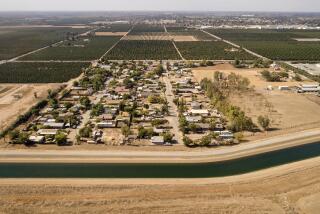A Thirsty World
- Share via
The new threat, like the old one, derives from water. The tsunami that killed at least 77,000 people in the Indian Ocean basin on Sunday has now put millions of others at grave risk of waterborne diseases such as cholera, hepatitis, dysentery and typhoid fever, according to the United Nations Children’s Fund.
Relief agencies have been working tirelessly to replenish the drinkable water wiped out after the waves swept away wells, contaminated filtration plants and destroyed miles of pipes. There is widespread agreement among these groups about the need for water buckets, chlorine tablets and other survival tools, which have been slow to reach the area because of flooded roads and other logistical problems. But when it comes to longer-term issues -- like how to rebuild those filtration plants and water mains -- there is no such unanimity. That’s largely because the current water shortage in Asia didn’t start with the tsunami.
More than 1 billion people worldwide, many of them in the areas hit by the tsunami, lack access to safe drinking water. The reason, according to the World Health Organization, is the steady decline, since 1997, in wealthy countries’ support for water purification programs. There are two reasons for this: One, water isn’t seen as a resource critical to national security or economic growth, the way oil is; and two, governments have increasingly opted to leave water programs to private industry.
In the mid-1990s, corporations backed by the World Bank began installing and operating water systems in needy countries. They did it on a for-profit basis, with the view that charging for water was essential if it was to be allocated efficiently. Critics, though, argue that water essential for life shouldn’t be privately controlled.
At an international summit in 2002, Secretary of State Colin L. Powell proposed spending $970 million over three years on an initiative that aimed to expand the supply of safe drinking water in poor countries, largely through privatization. Critics say such privatization schemes have been spectacular failures. They point, for instance, to the deadly uprising that erupted in Cochabamba, Bolivia, in 2000, after privatization spawned astronomical water rate hikes. Powell, however, counters -- correctly -- that the billions spent by industrialized nations in the 1990s to produce safe drinking water in poor countries haven’t made a dent in the problem.
One question facing the Bush administration and officials in relief agencies, therefore, is whether to depend on such free-market solutions in the future or do something more old-fashioned: partner with Asian nations and help them build the sort of large-scale, government-subsidized water systems that exist in California and Europe. As human populations grow and water becomes more scarce, the solution will probably involve a little of both.
More to Read
Sign up for Essential California
The most important California stories and recommendations in your inbox every morning.
You may occasionally receive promotional content from the Los Angeles Times.










